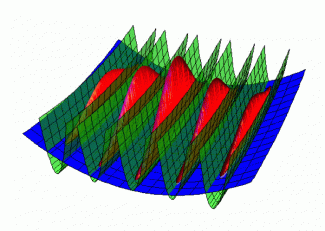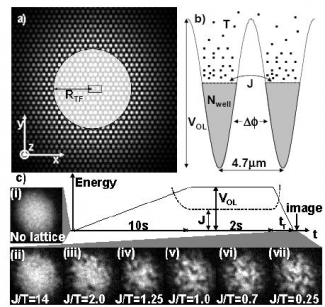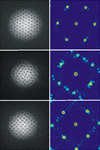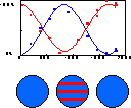
Members: Dan Lobser, Andrew Barentine, and Eric Cornell
Presuperfluid Regime in 2D Bose Gas
In complementary images of coordinate-space and momentum-space density in a trapped 2D Bose gas, we observe the emergence of pre-superfluid behavior. As phase-space density $\rho$ increases toward degenerate values, we observe a gradual divergence of the compressibility $\kappa$ from the value predicted by a bare-atom model, $\kappa_{ba}$. $\kappa/\kappa_{ba}$ grows to 1.7 before $\rho$ reaches the value for which we observe the sudden emergence of a spike at $p=0$ in momentum space. Momentum-space images are acquired by means of a 2D focusing technique. Our data represent the first observation of non-meanfield physics in the pre-superfluid but degenerate 2D Bose gas.
Phys. Rev. Lett. 105, 230408 (2010) cond-mat
Vortex proliferation in BKT regime
We observe the proliferation of vortices in the Berezinskii-Kosterlitz-Thouless regime on a two-dimensional array of Josephson-coupled Bose-Einstein condensates. As long as the Josephson (tunneling) energy J exceeds the thermal energy T, the array is vortex-free. With decreasing J/T, vortices appear in the system in ever greater numbers. We confirm thermal activation as the vortex formation mechanism and obtain information on the size of bound vortex pairs as J/T is varied.
Phys. Rev. Lett. 99, 030401 (2007) cond-mat
Vortex pinning
We report the observation of vortex pinning in rotating gaseous Bose-Einstein condensates (BEC). For pinning vortices a co-rotating optical lattice is superimposed onto a rotating BEC, creating columnar pinning sites inside the condensate. These pinning sites provide a spatial energy favorable configuration, and induce pinning force for the vortices. Two different types of optical lattice, triangular and square, are used in our experiment. As a result of pinning, with both triangular and square optical lattices, we see an orientation locking between the vortex and optical lattices. If a square optical lattice is applied, a structural phase transition of the vortex lattice has also been observed.
Phys. Rev. Lett. 97,240402 (2006) cond-mat
Vortex lattices in spinor BECs
We observe interlaced square vortex lattices in rotating two-component dilute-gas Bose-Einstein condensates (BEC). After preparing a hexagonal vortex lattice in a single component BEC in an internal state $|1>$ of $^{87}$Rb atoms, we coherently transfer a fraction of the superfluid to a different internal state $|2>$. The subsequent evolution of this pseudo-spin-1/2 superfluid towards a state of offset square lattices involves an intriguing interplay of phase-separation and -mixing dynamics, both macroscopically and on the length scale of the vortex cores, and a stage of vortex turbulence. Stability of the square lattice structure is confirmed via the application of shear perturbations, after which the structure relaxes back to the square configuration. We use an interference technique to show the spatial offset between the two vortex lattices. Vortex cores in either component are filled by fluid of the other component are filled by fluid of the other component, such that the spin-1/2 order parameter forms a Skyrmion lattice.
Phys. Rev. Lett. 93,210403 (2004) cond-mat
Equilibrium vortex properties
We characterize several equilibrium vortex effects in a rotating Bose-Einstein condensate. Specifically we attempt precision measurements of vortex lattice spacing and the vortex core size over a range of condensate densities and rotation rates. These measurements are supplemented by numerical simulations, and both experimental and numerical data are compared to theory predictions of Sheehy and Radzihovsky [17] (cond-mat/0402637) and Baym and Pethick [25] (cond-mat/0308325). Finally, we study the effect of the centrifugal weakening of the trapping spring constants on the critical temperature for quantum degeneracy and the effects of finite temperature on vortex contrast.
Phys. Rev. A 70, 063607 (2004) cond-mat
Lowest Landau Level
We create rapidly rotating Bose-Einstein condensates in the lowest Landau level, by spinning up the condensates to rotation rates $\Omega>99%$ of the centrifugal limit for a harmonically trapped gas, while reducing the number of atoms. As a consequence, the chemical potential drops below the cyclotron energy $2\hbar\Omega$. While in this mean-field quantum Hall regime we still observe an ordered vortex lattice, its elastic shear strength is strongly reduced, as evidenced by the observed very low frequency of Tkachenko modes. Furthermore, the gas approaches the quasi-two-dimensional limit. The associated cross-over from interacting- to ideal-gas behavior along the rotation axis results in a shift of the axial breathing mode frequency.
Phys. Rev. Lett. 92, 040404 (2004) cond-mat
Tkachenko waves
We directly image Tkachenko waves in a vortex lattice in a dilute-gas Bose-Einstein condensate. The low (sub-Hz) resonant frequencies are a consequence of the small but nonvanishing elastic shear modulus of the vortex-filled superfluid. The frequencies are measured for rotation rates as high as 98% of the centrifugal limit for the harmonically confined gas. Agreement with a hydrodynamic theory worsens with increasing rotation rate, perhaps due to the increasing fraction of the volume displaced by the vortex cores. We also observe two low-lying m=0 longitudinal modes at about 20 times higher frequency.
Phys. Rev. Lett. 91, 100402 (2003) cond-mat
Giant vortices
We study the formation of large vortex aggregates in a rapidly rotating dilute-gas Bose-Einstein condensate. When we remove atoms from the rotating condensate with a tightly focused, resonant laser, the density can be locally suppressed, while fast circulation of a ring-shaped superflow around the area of suppressed density is maintained. Thus a giant vortex core comprising 7 to 60 phase singularities is formed. The giant core is only metastable, and it will refill with distinguishable single vortices after many rotation cycles. The surprisingly long lifetime of the core can be attributed to the influence of strong Coriolis forces in the condensate. In addition we have been able to follow the precession of off-center giant vortices for more than 20 cycles.
Phys. Rev. Lett. 90, 170405 (2003) cond-mat
Vortex lattice dynamics
We have studied the dynamics of large vortex lattices in a dilute-gas Bose-Einstein condensate. While undisturbed lattices form a regular hexagonal lattice structure, large-amplitude quadrupolar shape modes are shown to induce a wealth of nonequilibrium lattice dynamics. Upon the excitation of an m = -2 mode, we have observed shifting of lattice planes, changes of lattice structure, and sheet-like structures in which individual vortices appear to have merged. Excitation of an m = +2 mode dissolves the regular lattice, leading to randomly arranged but still strictly parallel vortex lines.
Phys. Rev. Lett. 89, 100403 (2002) cond-mat
Vortex lattice nucleation
We have developed an evaporative cooling technique that accelerates the rotation of an ultracold 87Rb gas, confined in a static harmonic potential. As a normal gas is evaporatively spun up and cooled below quantum degeneracy, it is found to nucleate vorticity in a Bose-Einstein condensate. Measurements of the condensate's aspect ratio and surface-wave excitations are consistent with effective rigid-body rotation. Rotation rates of up to 94% of the centrifugal limit are inferred. A threshold in the normal cloud's rotation is observed for the intrinsic nucleation of the first vortex. The threshold value lies below the prediction for a nucleation mechanism involving the excitation of surface waves of the condensate.
Phys. Rev. Lett. 87, 210403 (2001) cond-mat
Solitons and Vortex rings
We have created spatial dark solitons in two-component Bose-Einstein condensates in which the soliton exists in one of the condensate components and the soliton nodal plane is filled with the second component. The filled solitons are stable for hundreds of milliseconds. The filling can be selectively removed, making the soliton more susceptible to dynamical instabilities. For a condensate in a spherically symmetric potential, these instabilities cause the dark soliton to decay into stable vortex rings. We have imaged the resulting vortex rings.
Phys. Rev. Lett. 86, 2926 (2001) cond-mat
Tilt modes
A vortex in a condensate in a nonspherical trapping potential will in general experience a torque. The torque will induce tilting of the direction of the vortex axis. We observe this behavior experimentally and show that by applying small distortions to the trapping potential, we can control the tilting behavior. By suppressing vortex tilt, we have been able to hold the vortex axis along the line of sight for up to 15 sec. Alternatively, we can induce a 180 deg tilt, effectively reversing the charge on the vortex as observed in the lab frame. We characterize the vortex nondestructively with a surface-wave spectroscopic technique.
Phys. Rev. Lett. 86, 2922 (2001) cond-mat
Vortex precession
We have observed and characterized the dynamics of singly quantized vortices in dilute-gas Bose-Einstein condensates. Our condensates are produced in a superposition of two internal states of 87Rb, with one state supporting a vortex and the other filling the vortex core. Subsequently, the state filling the core can be partially or completely removed, reducing the radius of the core by as much as a factor of 13, all the way down to its bare value of the healing length. The corresponding superfluid rotation rates, evaluated at the core radius, vary by a factor of 150, but the precession frequency of the vortex core about the condensate axis changes by only a factor of 2.
Phys. Rev. Lett. 85, 2857 (2000) cond-mat
First vortex nucleation and phase measurement
We have created vortices in two-component Bose-Einstein condensates. The vortex state was created through a coherent process involving the spatial and temporal control of interconversion between the two components. Using an interference technique, we map the phase of the vortex state to confirm that it possesses angular momentum. We can create vortices in either of the two components and have observed differences in the dynamics and stability.
Phys. Rev. Lett. 83, 2498 (1999) cond-mat
Untwisting superfluids
The order parameter of a condensate with two internal states can continuously distort in such a way as to remove twists that have been imposed along its length. We observe this effect experimentally in the collapse and recurrence of Rabi oscillations in a magnetically trapped, two-component Bose-Einstein condensate of 87 Rb.
Phys. Rev. Lett. 83, 3358 (1999) cond-mat
















